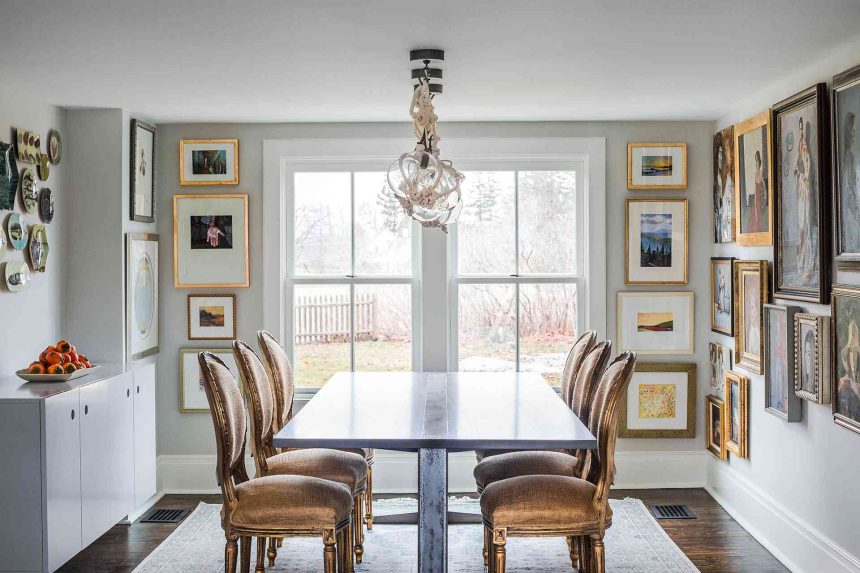The kitchen might be the heart of the home, but the dining room is where things really happen—it’s where we gather, catch up, and celebrate life’s little (and big) moments. Whether it’s a casual weeknight dinner or a festive holiday feast, this space sets the stage for great food, good company, and plenty of memorable conversations.
This year, expect to see a blend of bold lighting and rich, moody colors in the dining room, infusing fresh personality and warmth into this all-important space. Here, we spoke to interior designers about these and other dining room trends that will be big in 2025.
Statement Lighting
In 2025, dining rooms will embrace light fixtures that are equal parts style and illumination. “Bold pendant lights are becoming sculptural focal points above the table,” says Alyssa Anselmo, interior architect at and founder of Studio Anva. “They strike the perfect balance between function and personality, letting homeowners make a real statement.”
Daniel Joseph Chenin, principal designer and founder of Daniel Joseph Chenin Ltd., is seeing the same trend. He notes that lighting—think recessed LEDs paired with decorative sconces—is bringing newfound depth and drama to the dining space. “These fixtures aren’t just about light—they’re like pieces of art that set the mood and turn dining rooms into dynamic, inviting spaces,” he says.
Real, Solid Furniture
Martha Stewart
Fast furniture is on the way out, with more people leaning toward pieces that are built to last. “We’re seeing a shift back to craftsmanship—furniture is now being seen as an investment rather than just something trendy to fill a space,” says Anselmo. Solid wood tables and chairs are making a strong comeback thanks to their warmth, durability, and ability to age beautifully over time.
Dom Hage, founder of D. Hage Designs, suggests taking this trend a step further and thinking outside the box. Instead of traditional finishes, you can also bring in outdoor materials like stone, gesso, and polished concrete, creating a sturdy, handmade, and intimate feel.
Mixed Materials
Molly Winters Culver
If you’ve been holding onto that matching dining set, then it might be time for a change. “Mismatched sets are going to be huge this year,” says Hage. “It started gaining popularity last year, and now it’s evolving in even more fun ways.”
One way to get the look is to keep most pieces the same but add a statement element, like a vintage chair that really stands out. If you want a more cohesive look, try mixing up different materials within the same color family—like black chairs made of leather, iron, upholstery, or ebonized timber. “Think cousins, not twins,” adds Hage.
Nature’s Influence
Photography by Deborah Jaffe
Bringing the outdoors in isn’t just a trend—it’s becoming a signature feature of modern dining rooms. “Expansive windows and sliding glass doors that open up to patios or gardens are making interiors feel more connected to nature,” says Chenin. “This seamless flow not only enhances the dining experience, but floods the space with natural light.”
Sarah Comerford, founder and CEO of Studio Belle, emphasizes the importance of materials in creating a biophilic look. “Earthy tones and soft, organic textures like wool or linen help make the space feel grounded and inviting,” she says.
Layered Architectural Elements
Dining rooms are getting a major style upgrade in 2025, with layered architectural details that add both drama and sophistication. “Look for stunning timber cladding, intricate beams, and barrel-vaulted ceilings,” says Comerford.
Paneled wall treatments and decorative moldings are also on the rise, adding depth and elegance and transforming regular meals into something special. “These do more than just look good—they give a sense of permanence and character that homeowners are craving,” Comerford adds.
Moody Tones
Design:Emily Henderson Design; Photo:Zeke Ruelas
Deep, moody colors are making dining rooms feel more inviting, with rich blues, earthy greens, and warm browns replacing the once-popular whites and grays. “People are realizing that minimalist color schemes feel lifeless, and they’re craving spaces that feel soulful and inspiring,” says Anselmo.
After years of pristine, almost impersonal interiors, there’s now a shift toward depth and authenticity. “People are craving life, art, and depth—especially after the pandemic,” she adds. “We want our spaces to reflect the richness of the world around us.”
Private Dining
As the open-plan trend starts to fade, more homeowners are falling in love with the idea of dedicated dining spaces. “Defined areas create a sense of ritual and belonging,” says Anselmo. “People are craving spaces that feel safe and enveloping.”
And while open floor plans certainly offer flexibility, they can sometimes feel a little cold or lacking in purpose. By carving out specific spaces for dining, people can create areas that encourage slower meals and deeper conversations.






